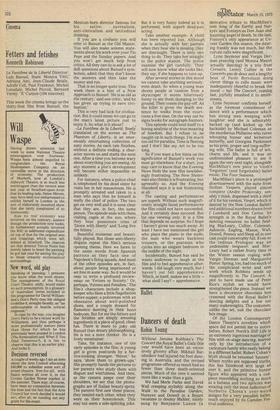Ballet
Dancers of death
Robin Young
Without Jerome Robbins's The Concert the Royal Ballet's Gala this year would have been an excessively gloomy affair. Mikhail Barishnikov had injured his foot dancing in Australia, and the revised programme offered as result had no fewer than three death-oriented pieces. Much of the time it seemed more like a wake than a gala.
We had Merle Parke and David Wall creeping stylishly along the Walk to the Paradise Garden; Nureyev and Dowell in a Bejart twosome to doomy Mahler, nicely sung by Benjamin Luxon (a derivative tribute to MacMillan's own Song of the Earth); and Nur eyev and Fonteyn as Don Juan and haunting angel of death. In the last, Fonteyn's only appearance at Co vent Garden this season, the dancing frankly was not much, but the curtain calls were magnificent.
Lynn Seymour and Vergie Derman prancing (and Monica Mason actually dancing) in a trio from Corsaire, Lesley Collier in the Concerto pas de deux and a lengthy bout of Paolo Bortoluzzi doing clever things to cello music were inadequately cheerful to break the mood — but The Concert, coming last, joyfully smashed it to smithereens.
Lynn Seymour confirms herself as the foremost comedienne of dance with a performance which has strong men weeping with laughter and she is admirably backed up (and kicked up the backside) by Michael Coleman as the murderous Philistine who turns whooping hussar and lecherous butterfly, and Georgina Parkinson as his prim, proper and long-suffer ing wife. The ballet is full of wit, charm and life, and it was an undiminished pleasure to see it
again the very next night, alongside MacMillan's new piece to Verdi's 'forgotten' (and forgettable) ballet music, The Four Seasons.
MacMillan's piece is a prolonged divertissement with the suite from Sicilian Vespers, played almost
complete (Andre Prokovsky, sensibly I think, dispensed with a third
of it for his version, Vespri, which is danced by the New London Ballet) and additional numbers drawn from I Lombardi and Don Carlos. Its strength is in the Royal Ballet's dancing resources: no ballet field ing MacLeary, Collier, Coleman, Ashmole, Eagling, Mason, Wall, Dowell, Penney and Sleep all in one cast could conceivably fail. Even so the tedious Prologue was an undeniable longueur, and Mac Leary had a rather frosty time in the Winter season coping with Vergie Derman and Marguerite Porter. Spring, too, had too much of the complicated wrist and arm work which Robbins sends up magnificently in The Concert. A plot to have made use of Peter Rice's stylish set would have strengthened the piece. Instead we have a decorative chocolate box. 'crammed with the Royal Ballet's dancing delights and a few too many makeweights. The costumes, unlike the set, suit the chocolate box image.
Of the London Contemporary Dance Theatre's novelties which space did not permit me to notice before, Robert North's Still Life is an extremely ingenious marriage of film with on-stage dancing, marred only by the introduction of a caricature family who really belong in a different ballet. Robert Cohan's Myth should be renamed 'fantasy'. Where myths are supposed truths, this has falsehood writ large all over it, and the primitive hunter figure who appeared with a cod piece resembling nothing so much as a banana and two apricots was wearing only the most ludicrous of Norberto Chiesa's over-weird designs for a very' pseudish ballet, much enjoyed by its Camden Festival audience.


































 Previous page
Previous page